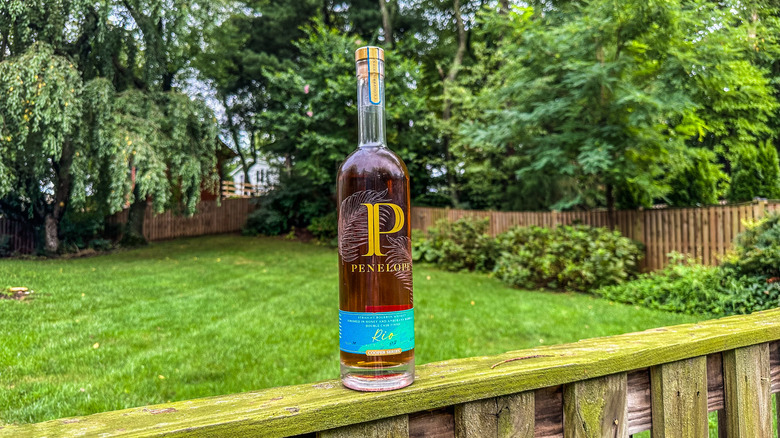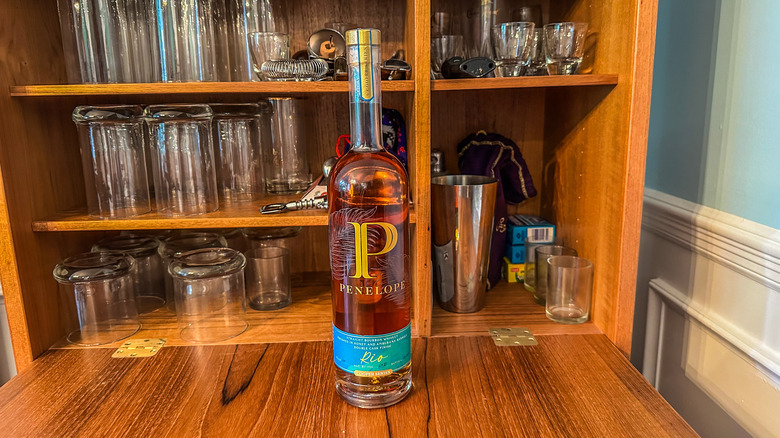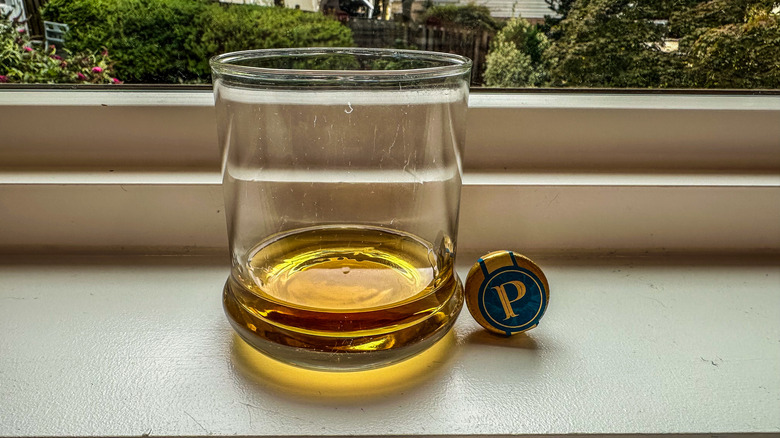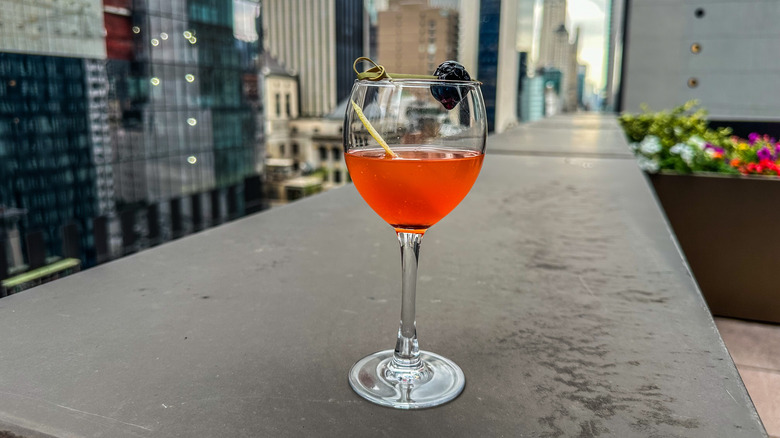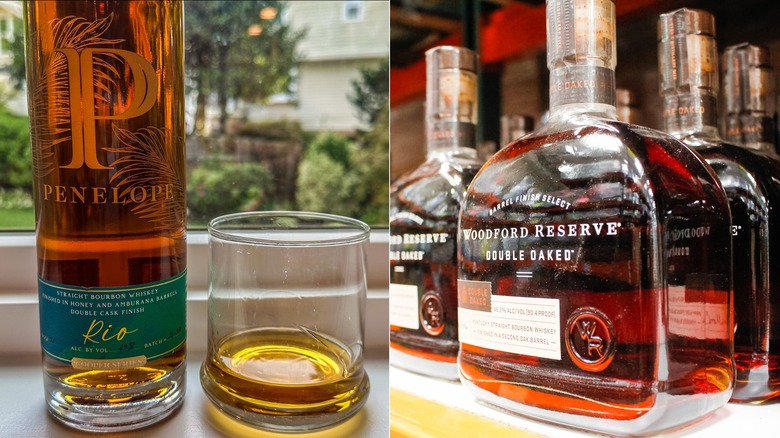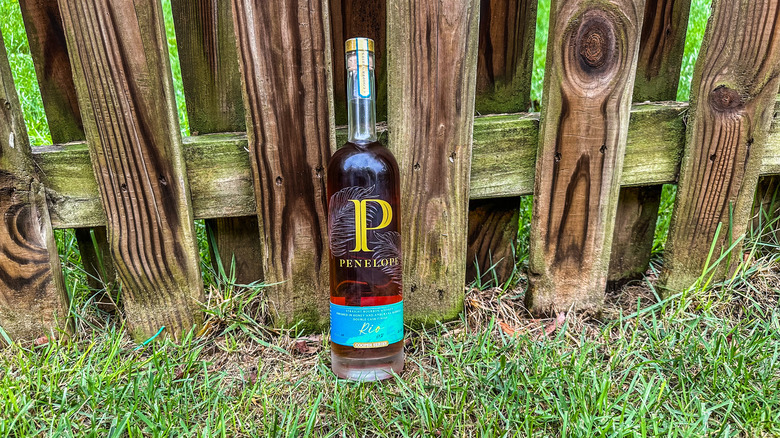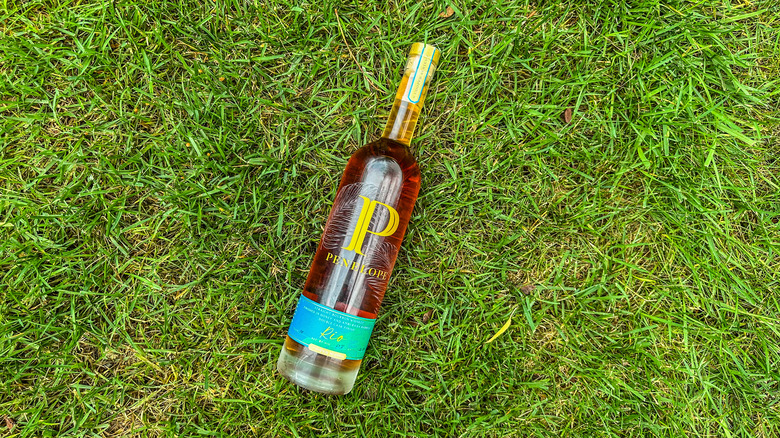Penelope Rio Bourbon: The Ultimate Bottle Guide
It's 2018, and Kelly and Mike Paladini are about to welcome the birth of their daughter, Penelope. Many may choose to celebrate with flowers, balloons, and perhaps a beautiful cake. The Paladinis, however — along with their close pal, Danny Polise — opted to celebrate with a bourbon instead. And so, as the story goes, Penelope Bourbon was born.
Penelope Bourbon started with its Core Series, made up of four bourbons — Four Grain, Architect, Barrel Strength, and Toasted Bourbon — all of which tend to be readily available at liquor stores nationwide, as well as on the Penelope Bourbon website. From there, the company has expanded to its Cooper Series, Limited Releases, and the Estate Collection, which are of a higher caliber and price point. Penelope Rio, a four-grain blend of three bourbon mash bills, is one of the bottles that makes the Cooper Series so special. As a limited release, only 5,000 cases were produced — and once it's gone, Penelope enthusiasts will have to wait for the next iteration, whenever that is.
In this Ultimate Bottle Guide, we take a dive into the production of Penelope Rio, as well as what makes this such a unique and worldly spirit. Even for the most learned of bourbon drinkers, a spirit like this is worth taking the time to get acquainted with, as there's so much to the story than what's in the bottle itself.
Some recommendations are based on firsthand impressions of promotional materials and products provided by the manufacturer.
How is Penelope Rio made?
Starting with a blend of three bourbon mash bills made up of four grains — 74% corn, 14% wheat, 9% rye, and 3% malted barley — Penelope Bourbon's Rio is aged in honey barrels for four years, and then finished in new Amburana barrels from Brazil for another two years. It is non-chill filtered for a more traditional bourbon flavor, and bottled at 98 proof for a flavorful, alcohol-forward sip.
Penelope Rio is a small batch bourbon, meaning the whiskey that's bottled comes from a small number of selected barrels. The term "small batch" may seem like marketing talk to make a product sound special and worthy of a potentially higher price tag, but when it comes to making bourbon, it carries a lot of weight with spirit enthusiasts. The careful barrel selection means more control over the flavor profile, resulting in a truly noteworthy sip every time. In the case of Penelope Rio, each barrel is hand selected and blended into a single batch. It's this attention to detail and meticulous production technique that sets Rio apart in the whiskey category.
What does this bourbon taste like?
To get a truly proper taste of Penelope Rio, we tasted it as a neat pour and with a splash of water. Both ways are enjoyable, as you get the purest form of the bourbon — but the water really helps to open up the aromas and flavors a bit more, allowing the warmth and spice to really come through. You may feel tempted to add ice, but adding even a single cube dilutes Rio a bit too much, taking away from all the flavor it has to offer.
After you remove the top from Rio, let the bottle breathe for a moment. No, you don't need to treat this like a red wine that requires decanting beforehand, but Rio's aromas do benefit from being able to come up and out on their own for a few moments before being poured. Right away, your olfactory is filled with notes of honey and brown sugar. In the glass, give Rio a healthy swirl, then go back in for another gentle inhale. Cinnamon, baking spices, and a hint of char stick around as you take that first sip.
Sweet and delicate, Rio is filled with the flavors of gingerbread, honey, and vanilla. Close your eyes, take another sip, and you can feel the warmth of a baked apple croissant or a bourbon pecan pie take over your taste buds. The finish is long and lingering, with wisps of warm spice.
How best to enjoy Penelope Rio
From production to flavor and just about everything in between, no two bourbons are exactly alike. As such, there's no definitive answer to the question, "How is bourbon best enjoyed?" Indeed, there's a good chance that, while one bourbon is destined to be sipped neat or with an ice cube, another is designed for cocktails. Penelope Rio manages to be an exception to this rule as a spirit that works just as perfectly as a neat pour as it does in a straightforward whiskey cocktail. With notes of honey and gingerbread, and a mélange of spice and fruity flavors as well, Rio is a bourbon lover's best-case scenario.
The list of whiskey cocktails is seemingly infinite (thank goodness for that), and while Penelope Rio is a shoo-in for just about any of them, it shines with simplicity. It may seem a bit on the nose for the brand to describe it as "a carnival in a bottle," but it's not just talk; there's a lot of flavor and spice and fire happening in each sip, and it deserves to be celebrated, not covered up.
Start simple with a paper plane, incorporating a balance of sweet and bitter with Penelope's notes of honey, cinnamon, and stone fruit. From there, move into something more nuanced, like a maple old fashioned. Laced with warm spices and citrus, Penelope Rio is the ideal base spirit to give this cocktail added depth and complexity.
Penelope Rio's cost and availability
When it comes to cost, good bourbon and whiskey tend to be up there as the more expensive spirits on the market, which, based on how they are made and how long it takes to make them, should come as no surprise. Penelope Rio, as a limited release from Penelope's Cooper Series, clocks in at a high-but-not-quite-luxury price point of $89.99 for a 750-milliliter bottle, depending on location and retailer. For a small batch, limited-edition spirit with a not-so-young age statement, this isn't exactly a surprising price — but it's high, nonetheless.
For the bourbon novice just getting into brown spirits for the first time, going straight for Penelope Rio may be out of the realm of possibility, whereas something like the Penelope Four Grain is a top-shelf choice at a mid-shelf price point. For the bourbon enthusiast or better yet, the collector, having a bottle of Penelope Rio at home may be just what you're looking for.
Just as the price makes Penelope Rio feel somewhat unattainable, its availability isn't all that different. As mentioned, Rio is a limited-edition expression with only 5,000 cases distributed across specialty retailers online and in high-end liquor stores nationwide. For those looking to dive deeper into the Penelope portfolio, Penelope has a Core Series with a wider array of lower-priced bourbons for purchase, as well as a Founders Reserve, all of which are available via the Penelope website, assuming they're still in stock.
Penelope Rio vs. Woodford Reserve Double Oaked
As double cask bourbons aren't incredibly common, when you do come across one, it's worth taking note. To get a better idea of how Penelope Rio stands up against another double cask bourbon, we compared this bottle to Woodford Reserve Double Oaked.
Starting with the mash bill, Penelope and Woodford Reserve start off on a different foot. Rio is composed of a four-grain mash, while Double Oaked is three grain, omitting the wheat. From there, Penelope seemingly takes its aging a step further than Woodford Reserve, spending four years in American honey oak barrels and an additional two years finishing in Amburana barrels from Brazil, as mentioned. It is then bottled at 98 proof for a well-rounded, complex flavor and a spicy, almost chocolatey finish. Woodford Reserve is bottled at 90.4 proof; and while the exact aging time is unknown, it also uses the double barrel aging method — two charred American oak barrels, the latter of which is also toasted for the finishing, resulting in a more traditional flavor profile of vanilla, dark caramel, and fruit.
The final major difference between these two is in the price. While Rio is nearing the luxury category, Double Oaked comes in lower at around $65. For a bourbon newbie, this jump in price can be a deal breaker. Meanwhile, the bourbon enthusiast looking to upgrade to something with a little more character may see Rio as the logical next step in their bourbon journey.
This bourbon's barrel aging process is unique
Barrel aging is a crucial part of the whiskey production process, and a good distiller will source barrels with certain characteristics to ensure that the wood can impart its best qualities and flavors into the liquid. As mentioned, in the case of Penelope Rio, two barrels are used, starting with a honey barrel for the first part of the aging process, then followed by Brazilian Amburana barrels for the finish.
So what makes these barrels so special? Starting with the honey barrels, there is a reputation that these barrels have earned. According to an article about honey barrels from Whisky Advocate, honey barrels have been around in the bourbon zeitgeist for decades. And while "honey barrel" isn't an official term, for those in the know, it's a sign of something good. Consultant and expert blender Nancy Fraley describes the barrels as "everything you want — wood sugars, just the right amount of tannins for structure, spice, fruit. ... It's a perfect barrel that doesn't even necessarily need to be blended."
The use of Amburana barrels takes things a step further. Amburana wood comes from Brazil and Argentina's dry regions, and it's known for its attractive look and scent, specifically notes of vanilla and spice. While the use of this wood is primarily seen in Brazilian liquors, its popularity has made its way into beer and whiskey categories, as well.
Penelope Rio's four-grain mash bill is also uncommon
Wheat. Corn. Malted barley. Rye. Oats. These are words we hear when talking about whiskey, specifically what's going into the whiskey's mash bill. Before that magical liquid hits your lips, it goes through a production process just like anything else, and there are a lot of ingredients putting in the legwork to make it great. In the case of Penelope Rio — and Penelope Bourbon as a brand in general — the mash bill is yet another example of outside-the-box thinking.
While most distillers tend to work with a three-grain mash bill, Rio uses four, and in a very specific percentage breakdown. Each grain brings something different to the liquid, ensuring that every element of the flavor, texture, and aroma is taken care of. There's a reason some bourbon enthusiasts believe an argument could be made for four-grain bourbons, as they result in a more complex flavor than a three-grain varietal. For example, the 74% corn in Rio contributes sweet notes like vanilla, caramel, and butterscotch, as well as a smoother sip, while the 9% rye brings just enough fiery heat and spice to give Rio added depth and breadth.
